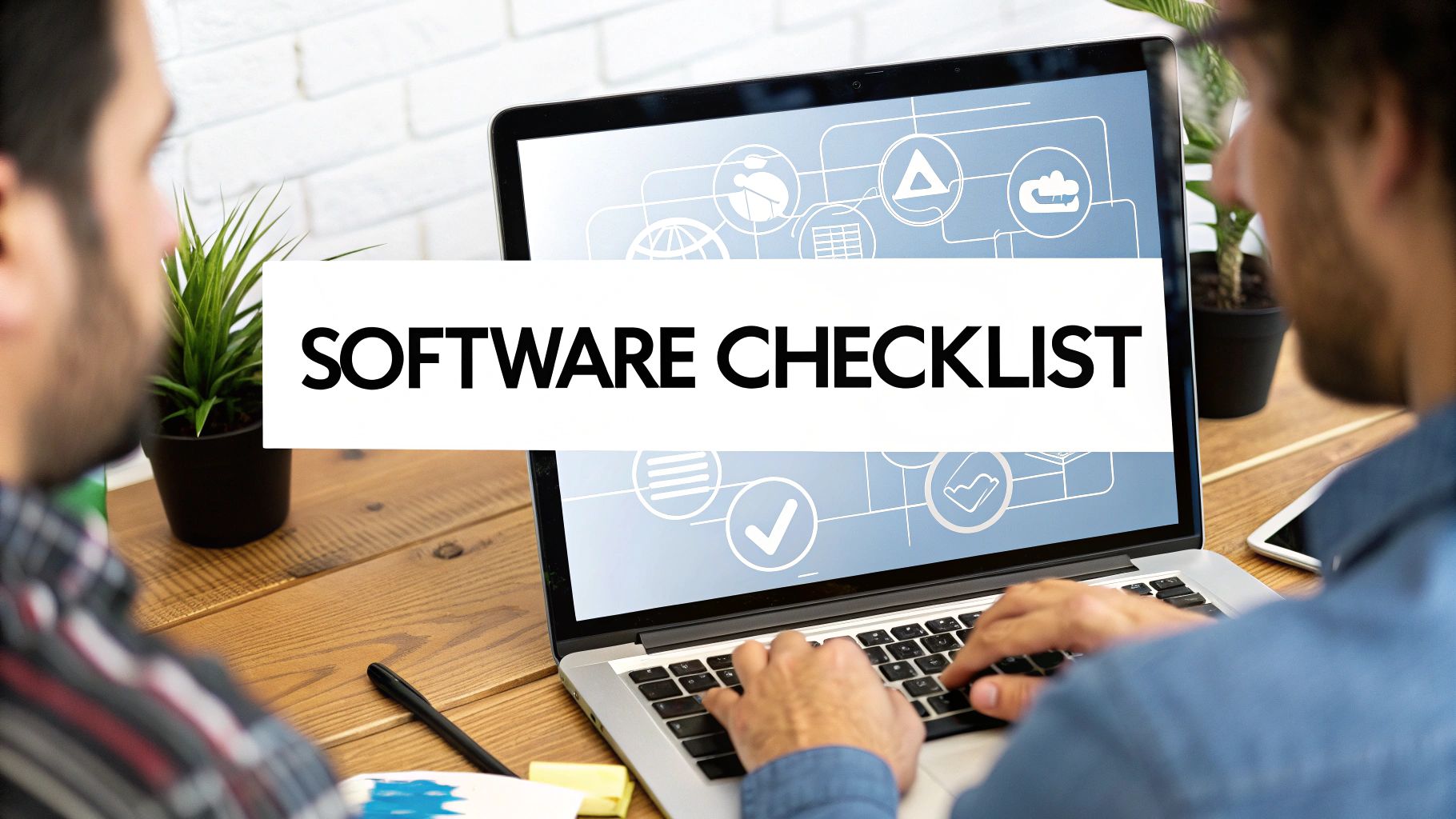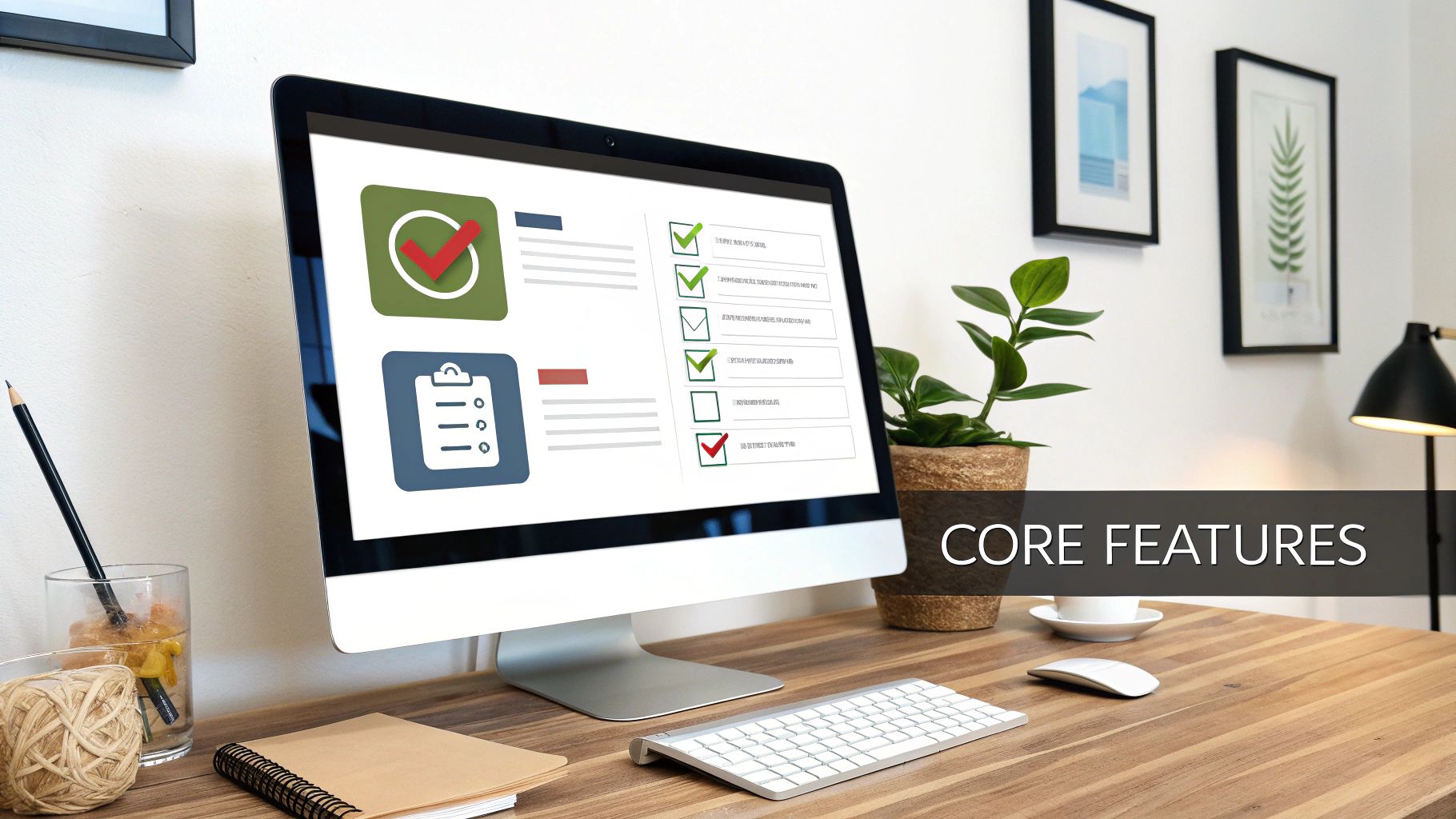Navigating the Software Jungle: A Checklist for Success
Choosing the right software can feel overwhelming. With so many options available, it's easy to get lost in confusing jargon and hidden pitfalls. From the early days of punch cards to today's cloud-based applications, software has drastically changed how we work and live. But the core challenge remains: how do we choose tools that empower us, and avoid those that hinder us?
Effective software evaluation goes beyond simply checking features. It requires understanding the core principles of successful implementation, from initial functionality to long-term costs and security. While IT departments once drove software adoption, the rise of SaaS has democratized the process, putting the power of choice in the hands of everyone from business professionals to entertainment consumers.
This understanding is more critical than ever. The sheer number of software options and the increasing complexity of our digital lives make informed decisions paramount. Why does one software solution thrive while another fails? The answer lies in a systematic evaluation process.
The 8-Point Checklist
This 8-point checklist provides the essential knowledge to navigate software selection, covering crucial aspects from user experience to security.
- User Experience: Is the software intuitive and easy to use?
- Functionality: Does it meet your specific needs and requirements?
- Performance: Is it fast, reliable, and efficient?
- Integration: Does it work seamlessly with your existing systems?
- Security: Does it protect your data and privacy?
- Scalability: Can it grow with your business or needs?
- Cost: Is it affordable and within your budget?
- Support: Does the vendor offer adequate training and assistance?
By using this checklist, you'll have a powerful toolkit to confidently evaluate any software and make informed decisions aligned with your specific needs, paving a clear path to software success.
1. Functionality and Features
At the heart of successful software lies its functionality: the ability to perform its intended purpose effectively and efficiently. Therefore, evaluating functionality is the first critical step in any software evaluation checklist. This process assesses how well the software delivers its promised capabilities.
This assessment examines three key aspects: whether the software includes all the necessary features, functions correctly without errors, and meets the specific needs of its users. It also ensures alignment with defined business requirements. This is paramount because software that doesn't perform its core functions reliably is essentially useless, regardless of any other appealing aspects.
Key Features of Functionality Evaluation
The evaluation process encompasses several key features:
- Feature Completeness Assessment: This checks if the software has all the features needed to achieve its stated objectives. It involves a meticulous comparison against a predefined list of required functionalities.
- Function Execution Accuracy: This verifies that features perform their intended tasks correctly and consistently, producing the expected results without errors.
- Business Requirements Alignment: This ensures the software effectively addresses the specific needs and challenges of the business or organization implementing it. It requires clearly articulated business objectives carefully mapped to the software's capabilities.
- Technical Specifications Compliance: This confirms adherence to relevant technical standards and specifications, ensuring interoperability, security, and maintainability.
- Core Capability Measurement: This involves quantifying the performance of the software's core functions using metrics such as processing speed, throughput, and accuracy.
Benefits of Focusing on Functionality
Prioritizing functionality and features offers several significant benefits:
- Direct Value Measurement: Evaluating core functionality provides a direct understanding of the value delivered to end-users, ensuring their needs are met.
- Early Gap Identification: Identifying missing or inadequate features early allows for timely remediation, preventing costly rework later.
- Clear Acceptance Testing Metrics: Functionality evaluation provides objective criteria for acceptance testing, ensuring the software meets defined performance benchmarks before deployment.
Potential Drawbacks of Focusing on Functionality
While focusing on functionality is crucial, there are potential drawbacks to consider:
- Feature Bloat: An excessive focus can lead to unnecessary features, increasing complexity and potentially hindering usability.
- Subjectivity Challenges: Aspects like user experience can be subjective and difficult to measure objectively.
- Evolving Requirements: Business needs and technology can change during evaluation, requiring adjustments to the criteria.
Real-World Examples of Functionality Evaluation
Real-world examples highlight the importance of functionality evaluation. Microsoft meticulously evaluates its Office software against feature checklists tailored to specific user personas. Banking software evaluations typically involve comprehensive transaction processing matrices. Healthcare systems are rigorously evaluated against clinical workflow functionality requirements to ensure efficient and accurate patient care.
Tips for Effective Functionality Evaluation
Here are some tips for conducting effective functionality evaluations:
- Prioritize Features: Create a comprehensive feature matrix, clearly designating "must-have" versus "nice-to-have" features.
- Real-World Testing: Test functions with real-world scenarios and data, not just ideal conditions.
- End-User Involvement: Involve actual end-users in functionality validation for valuable feedback.
- Weight by Business Impact: Weight features according to their business impact to prioritize those contributing most to organizational success.
The importance of functionality evaluation is further emphasized by its inclusion in established software engineering standards and frameworks like ISO 25010, the IEEE Software Engineering Standards Committee, and CISQ (Consortium for IT Software Quality). These organizations contribute to standardizing software quality evaluation, highlighting the critical role of functionality. Check out our article about Pick Alternative Sitemap for more information.
By prioritizing functionality and features, you lay the foundation for selecting and implementing software that effectively meets your needs and contributes to your overall success.
2. Usability and User Experience
Usability and user experience (UX) are paramount when evaluating software. This criterion measures how intuitive, efficient, and satisfying the software is for its end-users. It considers the user interface (UI) design, navigation flow, learnability, and overall experience. The goal is to ensure the software can be used effectively with minimal frustration or training. A well-designed user experience fosters user adoption, reduces training needs, and can even provide a competitive advantage.
Several key features contribute to a positive user experience:
- Interface clarity and consistency
- Efficient and intuitive navigation
- Ease of learning
- Accessibility compliance
- Measurable user satisfaction metrics
- Mechanisms for error prevention
For example, consistent button placement and predictable behavior contribute to interface clarity. Intuitive navigation ensures users can easily find what they need.
The History and Importance of Usability
The importance of usability gained significant traction with the work of pioneers like Jakob Nielsen, known for his 10 usability heuristics, and Don Norman, author of The Design of Everyday Things. These principles, along with standards like ISO 9241-210 (Ergonomics of human-system interaction), have helped formalize usability evaluation. The efforts of organizations like the User Experience Professionals Association (UXPA) have also been instrumental in integrating usability into software development.
Real-World Examples of Usability in Action
Real-world examples of usability evaluations are plentiful. Apple's Human Interface Guidelines dictate usability criteria for iOS applications, ensuring a consistent experience. The Nielsen Norman Group conducts rigorous usability evaluations of various software, offering valuable insights. Google's Material Design principles provide a framework for creating user-friendly Android software. These examples illustrate how usability testing and adherence to established principles contribute to successful products. You might be interested in: Our Pick Alternative Sitemap for more resources.
Pros:
- Directly impacts user adoption and satisfaction
- Reduces training and support costs
- Identifies friction points before deployment
- Can provide a competitive advantage
Cons:
- Often subjective and varies between user groups
- Can be expensive to test properly
- May conflict with functionality requirements
Tips for Effective Usability Evaluations:
- Conduct testing with actual end-users representing different skill levels.
- Use standardized metrics like the System Usability Scale (SUS).
- Evaluate against established heuristics like Nielsen's 10 usability principles.
- Incorporate accessibility testing for inclusive design.
- Test with various devices and screen sizes, if applicable.
By focusing on usability and UX, you ensure your software is not just functional, but also enjoyable and efficient. Ultimately, this leads to higher user satisfaction and a more successful product.
3. Reliability and Stability
When evaluating software, reliability and stability are paramount. These qualities reflect how consistently a software application performs its intended function over time, and under different conditions. Whether you're a developer, a business professional, or even just a casual streamer, reliable software means uninterrupted productivity and a smooth experience.
This evaluation process dives into several key aspects:
- System Uptime Percentage: This measures the percentage of time the software is up and running.
- Failure Rate Measurement: This tracks how often the software malfunctions.
- Mean Time Between Failures (MTBF): This indicates the average time between failures.
- Fault Tolerance Capabilities: This measures the software's ability to function even with hardware or software problems.
- Recovery Time and Procedures: This encompasses the time and steps needed to restore the software after a failure.
- Error Handling Effectiveness: This assesses how well the software manages and reports errors without crashing.
- Data Integrity Maintenance: This crucial aspect ensures data accuracy and consistency, even during disruptions.
Why Reliability Matters
Consider the potential impact of a financial platform crashing during market hours, or a healthcare system going down during a critical procedure. The repercussions can be severe. Reliability minimizes such risks, ensuring business continuity, maintaining user trust, and preventing data loss. It's an essential consideration in any software evaluation.
Pros and Cons of Focusing on Reliability
Focusing on reliability offers several benefits:
- Essential for Mission-Critical Applications: Reliability is non-negotiable in sectors like healthcare, finance, and aerospace.
- Reduces Disruptions: Reliable software minimizes downtime and associated costs.
- Builds User Trust: Consistent performance fosters confidence in the software.
- Prevents Data Loss: Reliability helps protect valuable data from corruption or loss.
However, achieving high reliability comes with challenges:
- Extensive Testing Required: Thorough testing under various conditions, including stress and load testing, is crucial.
- Simulating Failures: Replicating all possible failure scenarios can be complex.
- Specialized Tools: Dedicated testing environments and tools may be necessary.
Real-World Examples of Reliability in Action
The importance of reliability is evident in numerous high-stakes scenarios:
- Space Exploration: Software reliability is paramount for NASA's space missions, demanding rigorous testing and redundancy.
- Financial Trading: High-frequency trading necessitates near-perfect uptime, often striving for "five nines" (99.999%) availability.
- Healthcare Systems: Reliable software supports continuous patient monitoring and access to critical medical data.
The Evolution of Reliability
The emphasis on software reliability has evolved significantly. Pioneering work by companies like IBM in reliability engineering laid the groundwork. The rise of cloud computing and distributed systems further underscored its importance. Netflix's Chaos Monkey, a tool for deliberately causing system failures, popularized the concept of chaos engineering. Organizations like NIST (National Institute of Standards and Technology) and the IEEE Reliability Society also play key roles in defining reliability guidelines.
Practical Tips for Implementing Reliability Testing
Several techniques help ensure software reliability:
- Stress Testing: Pushing the software to its limits under extreme conditions helps identify breaking points.
- Load Testing: Evaluating performance under expected and peak loads helps identify bottlenecks.
- Chaos Engineering: Introducing controlled disruptions reveals vulnerabilities and improves resilience.
- Recovery Testing: Verifying data integrity and recovery procedures after failures.
- Error Monitoring: Analyzing error logs and crash reports provides insights into potential problems.
- Backup and Restore Testing: Validating backup and restore mechanisms ensures data recoverability.
Prioritizing reliability and stability in software evaluation mitigates risks, builds user trust, and ensures consistent performance across various sectors and applications.
4. Performance and Efficiency
Performance and efficiency are critical when evaluating any software. This criterion assesses how well software uses system resources (CPU, memory, network, and storage) and how quickly it responds. Slow software can frustrate users, impacting productivity and even a business's bottom line. Understanding software performance is vital for everyone from tech enthusiasts and business professionals to digital marketers and even entertainment consumers.
This evaluation includes several key features:
- Response Time Measurement: How quickly the software reacts to user actions.
- Throughput Capacity: The amount of data processed in a given time.
- Resource Utilization Efficiency: How well the software uses resources like CPU and memory.
- Scalability Under Increased Load: Maintaining performance with more users or data.
- Latency Under Various Conditions: Response delays under different network conditions.
- Startup and Shutdown Times: How long it takes to launch and close the software.
- Memory Leakage Assessment: Identifying if the software uses increasing memory over time, potentially degrading performance.
Why is this important? Performance directly affects user satisfaction. A slow website can lose customers, while a slow application can hinder workflows. Evaluating performance beforehand helps identify bottlenecks and determine hardware needs, saving time and resources.
Pros of Evaluating Software Performance
- Direct impact on user satisfaction and productivity.
- Identifies potential bottlenecks before deployment.
- Helps determine hardware requirements.
- Offers measurable metrics for comparison.
Cons of Evaluating Software Performance
- Performance can differ across environments.
- Testing may require specific tools and expertise.
- Optimization can add to development complexity and cost.
Real-World Examples of Performance Optimization
- Amazon: Continuously optimizes its platform to handle peak shopping times.
- Google Chrome: Regularly publishes performance benchmarks comparing its speed to other browsers.
- Financial Trading Platforms: Require incredibly fast response times, highlighting the crucial role of performance in this industry.
The importance of software performance has grown significantly, driven by user expectations and complex applications. Pioneers like Donald Knuth, with his work on optimization, and organizations like the W3C's Web Performance Working Group have advanced performance evaluation. Tools like Apache JMeter and LoadRunner are popular for performance testing, simulating user loads and identifying bottlenecks.
Tips for Performance Testing
- Create benchmarks: Establish specific, measurable performance indicators.
- Realistic testing: Simulate real-world scenarios with realistic data and user loads.
- Resource profiling: Monitor resource usage under various conditions.
- Minimum hardware testing: Test on the minimum required hardware.
- Comparative testing: Compare performance against competitors or earlier versions.
By prioritizing performance and efficiency, you ensure a positive user experience, boost productivity, and prevent costly future issues. This is a crucial part of any software evaluation, impacting everything from user satisfaction to business success.
5. Security and Compliance
In today's interconnected world, software security is paramount. A single vulnerability can expose sensitive data, damage your reputation, and lead to substantial financial losses. Therefore, "Security and Compliance" is a critical component of any software evaluation checklist. This step assesses how effectively the software protects data, prevents unauthorized access, and mitigates potential risks.
This evaluation covers various security aspects, including:
-
Authentication and Authorization Controls: How does the software verify user identities and manage access to specific features? Strong password policies, multi-factor authentication, and role-based access control are essential.
-
Data Encryption (at Rest and in Transit): Is data encrypted both when stored and during transmission? Encryption protects data confidentiality and integrity.
-
Vulnerability Assessment Results: Has the software undergone rigorous testing for known vulnerabilities? Penetration testing and vulnerability scanning are critical practices.
-
Compliance with Industry Regulations: Does the software adhere to relevant industry regulations such as GDPR, CCPA, HIPAA, or PCI DSS? Compliance is crucial for avoiding legal penalties and maintaining customer trust.
-
Audit Logging Capabilities: Does the software track user activities and system events? Audit logs are invaluable for forensic analysis and security incident investigations.
-
Session Management Security: How are user sessions managed to prevent hijacking? Secure session management is crucial for protecting user accounts.
-
Input Validation and Sanitization: Does the software validate and sanitize user inputs to prevent injection attacks? This is a fundamental security measure to prevent malicious code execution.
-
Security Patch Management: How frequently are security updates released and applied? Timely patching is crucial for mitigating new vulnerabilities.
Pros of Robust Security Measures
-
Prevent Costly Data Breaches: Investing in secure software mitigates the risk of financial loss, legal liabilities, and reputational damage.
-
Ensure Regulatory Compliance: Compliant software helps organizations meet legal obligations and avoid fines.
-
Build Customer Trust: Demonstrating a commitment to security fosters trust and enhances brand reputation.
-
Provide Systematic Security Review: The evaluation process provides a comprehensive overview of the software's security posture.
Cons of Implementing Strong Security
-
Performance and Usability Impact: Robust security measures can sometimes impact performance or add complexity to the user experience.
-
Need for Specialized Expertise: A thorough security evaluation requires specialized knowledge.
-
Ongoing Assessment Required: Security is an ongoing process, requiring continuous monitoring and adaptation.
Real-World Security Examples
- Banking software evaluated against PCI DSS requirements.
- Healthcare applications certified for HIPAA compliance.
- Government systems evaluated against the NIST cybersecurity framework.
Evolution of Security Practices
The increasing prevalence of cyberattacks has driven the evolution of software security. Organizations like OWASP, NIST, and ISO/IEC have played a key role in defining security standards.
Tips for Implementing Security Measures
- Conduct penetration testing by qualified professionals.
- Use automated vulnerability scanning tools.
- Review security architecture and threat models.
- Verify compliance with relevant regulations.
- Assess vendor security practices.
By thoroughly evaluating software security and compliance, organizations can protect data, maintain customer trust, and safeguard their bottom line. This crucial step ensures the chosen software aligns with security best practices and minimizes risks.
6. Maintainability and Support
Maintainability and support are often overlooked when evaluating new software. The initial excitement over features and functionality can overshadow the importance of long-term viability. Think of it like buying a car: You wouldn't purchase one without considering the maintenance costs. Software is similar – a seemingly great deal upfront can quickly become a burden if maintainability isn't considered.
This involves assessing several key factors:
-
Code Quality and Structure Assessment: Clean, well-structured code is much easier to understand and modify. Poorly written code can lead to a "spaghetti code" mess, making future updates challenging and prone to errors.
-
Documentation Completeness: Comprehensive documentation is essential. It helps everyone understand how the software works, troubleshoot issues, and train new users.
-
Vendor Support Options and SLAs: Understanding the vendor's support offerings, including their Service Level Agreements (SLAs), is crucial. This ensures timely issue resolution and minimizes potential downtime.
-
Update and Patch Management Processes: Efficient update processes are key for incorporating new features, fixing bugs, and addressing security vulnerabilities.
-
Customization Capabilities: Can the software be customized to meet your specific business needs? This flexibility can significantly enhance its value and longevity.
-
Technical Debt Evaluation: Technical debt refers to quick fixes that create future problems. Evaluating existing technical debt is crucial for long-term maintainability.
-
Knowledge Transfer Provisions: Ensure a smooth transfer of knowledge about the software. This reduces dependency on specific individuals or the vendor. This can be achieved through thorough documentation or training.
Why Is Maintainability Important?
Prioritizing maintainability offers numerous benefits:
-
Reduced Total Cost of Ownership: Maintainable software minimizes the effort required for updates and modifications, significantly reducing long-term costs.
-
Faster Adaptation to Changing Requirements: Well-maintained and flexible software allows you to adapt more quickly to evolving business needs.
-
Minimized Dependency: Good documentation and knowledge transfer reduce reliance on specific individuals or vendors for support and maintenance.
-
Smoother Upgrades and Migrations: Well-structured code and clear update processes simplify upgrades and migrations to newer versions.
Challenges in Evaluating Maintainability
Despite its importance, evaluating maintainability can be challenging:
-
Often Overlooked: The initial focus on immediate features often overshadows the long-term implications of maintainability.
-
Difficult to Quantify: Assessing code quality and documentation can be subjective and difficult to measure objectively.
-
Access Restrictions: A thorough evaluation might require access to source code or internal documentation, which may not be readily available.
Real-World Examples of Maintainability
Several popular software solutions exemplify good maintainability practices:
-
Salesforce: Known for its regular release cycle and comprehensive upgrade documentation, simplifying the process of staying current.
-
Linux Distributions (e.g., Ubuntu LTS): Long-term support (LTS) releases provide stability and maintenance updates for an extended period.
-
SAP: Offers tiered maintenance and support programs, allowing businesses to choose the level of support that best suits their needs.
Practical Tips for Evaluating Maintainability
Here are some practical tips to help you assess software maintainability:
-
Review Support History: Check online forums and review sites for insights into a vendor's support performance.
-
Evaluate Security Patching: A vendor's commitment to timely security updates demonstrates their dedication to maintainability.
-
Assess Documentation Quality: Thorough and well-written documentation is essential for long-term maintainability.
-
Check for Active Communities: Active developer/user communities offer valuable support and knowledge sharing.
-
Review API Stability: Understanding API stability ensures integrations remain functional after updates.
The importance of maintainability is emphasized by influential figures like Martin Fowler and Robert C. Martin, and by standards like ISO/IEC 25010. The DevOps movement, with its emphasis on continuous integration and continuous delivery (CI/CD), also highlights the importance of building and maintaining software for long-term viability. By prioritizing maintainability during software evaluation, you're making a smarter, more cost-effective technology investment that can adapt and evolve with your business.
7. Integration and Compatibility
In today's interconnected world, software rarely operates in isolation. Assessing a software's integration and compatibility is vital to ensure it seamlessly integrates into your current technology environment and boosts overall operational efficiency. This criterion examines how well the new software connects with other systems, exchanges data, and functions within your specific technical setup. Overlooking this aspect can create data silos, necessitate manual processes, and ultimately, limit the software's ability to streamline your operations.
This evaluation involves examining several key aspects: the strength and documentation of its API (Application Programming Interface), support for established protocols, data import/export functionalities, platform compatibility (Windows, macOS, Linux, etc.), integration methods (e.g., direct API calls, middleware), cross-browser/device compatibility, and critically, its capacity to connect with legacy systems.
For instance, Salesforce's comprehensive API and AppExchange ecosystem allow extensive customization and integration with numerous other applications, showcasing a significant emphasis on integration. Likewise, Microsoft's Office 365 suite excels at integrating its various applications, allowing seamless data flow between Word, Excel, PowerPoint, and other programs. Even Enterprise Resource Planning (ERP) systems, traditionally complex, now offer pre-built connectors to commonly used business applications, making integration easier.
The advantages of robust integration capabilities are many. Preventing data silos and enabling smooth information flow is a primary benefit, minimizing duplicate data entry and manual tasks. It allows you to capitalize on current technology investments, maximizing their value, and facilitates business process automation across multiple systems. Imagine your CRM automatically updating your marketing automation platform with new lead information – this level of integration saves time and minimizes errors.
However, it's crucial to be mindful of potential drawbacks. Integration complexity can substantially increase implementation time and may require additional middleware or connectors, increasing project costs. Moreover, future updates to connected systems can disrupt existing integrations if not properly managed.
Tips for Smooth Integration
To ensure a straightforward integration process, consider these practical tips:
- Map Existing Systems: Understand your current technology environment and pinpoint the specific systems needing interaction with the new software.
- Test API Functionality: Go beyond the provided documentation and test the API with real-world scenarios applicable to your business needs.
- Verify Compatibility: Don't assume general compatibility; confirm compatibility with the specific versions of the systems you employ.
- Evaluate Authentication: Security is paramount. Understand how the systems authenticate each other and ensure strong security measures are in place.
- Assess Data Transformation: If your systems use different data formats, ensure the software can efficiently transform data for seamless exchange.
The significance of integration and compatibility is underscored by organizations like MuleSoft, a leading integration platform provider, and methodologies like Enterprise Application Integration (EAI). Standards bodies like the IETF (Internet Engineering Task Force) and W3C (World Wide Web Consortium) also play a vital role in ensuring interoperability and web standards compatibility. For additional resources, visit Our Sitemap. This focus on integration highlights its crucial role in software effectiveness. By thoroughly evaluating this aspect, businesses can ensure their chosen software strengthens their infrastructure and promotes efficient, interconnected workflows.
8. Total Cost of Ownership (TCO)
Beyond the initial price tag, understanding the total cost of ownership (TCO) is crucial for making sound software decisions. TCO evaluates the complete financial impact of acquiring, implementing, and maintaining software throughout its lifecycle. This provides a comprehensive view of the software's economic impact on your organization. It's not simply about the upfront cost; it includes everything from licensing and implementation to ongoing maintenance, training, and potential future upgrades. Overlooking TCO can lead to unexpected expenses and budget overruns, making a seemingly affordable solution quite expensive over time.
Why TCO Matters in Software Evaluation
Organizations regularly adopt new software solutions to improve operations and increase productivity. While the initial purchase price is often the primary focus, it only represents a small part of the actual cost. Hidden expenses, like integration efforts, staff training, and ongoing maintenance, can quickly accumulate and significantly impact the overall budget. A proper TCO analysis helps compare solutions fairly, even when evaluating very different options like on-premise software versus cloud-based Software as a Service (SaaS) offerings.
Features to Consider in a TCO Evaluation
A comprehensive TCO analysis should include the following cost categories:
-
Initial acquisition costs: This includes the purchase price of the software licenses or the initial subscription fee.
-
Implementation and migration expenses: Costs associated with setting up the software, data migration, and integration with existing systems.
-
Licensing model assessment: Evaluating perpetual licenses versus subscription models to determine the most cost-effective approach.
-
Ongoing subscription/maintenance fees: Recurring costs for using the software, including updates and support services.
-
Infrastructure requirements and costs: Hardware, software, and networking resources needed to run the software effectively. Cloud solutions may change these costs, but they don't disappear.
-
Training and change management expenses: Costs associated with training employees on the new software and managing the organizational changes.
-
Operational staffing needs: Potential increases in staff or changes in roles required to manage and maintain the new software.
-
Upgrade and transition costs: Expenses related to future software upgrades, including potential data migration and retraining.
Pros and Cons of TCO Analysis
Pros:
- Provides a complete financial picture: Goes beyond the initial price to reveal the true long-term cost.
- Enables accurate budgeting and financial planning: Helps organizations allocate resources efficiently and avoid unexpected costs.
- Facilitates fair comparison between different solutions: Allows for a direct comparison of various options.
- Identifies hidden costs: Uncovers potential expenses that might be missed.
Cons:
- Difficult to predict all future costs: Accurately forecasting long-term expenses can be a challenge.
- Requires extensive financial modeling: A thorough TCO analysis requires detailed data gathering and analysis.
- Some costs may be subjective or organization-specific: Certain costs, like productivity impact, can be hard to quantify objectively.
Practical Tips for Implementing TCO Analysis
- Create a 3-5 year projection: Include all relevant cost categories for a realistic long-term perspective.
- Consider both direct and indirect costs: Factor in not only direct expenses but also indirect costs like productivity gains or losses.
- Account for scaling costs: Consider how costs might change as your usage increases.
- Include opportunity costs and transition expenses: Account for the cost of not choosing alternative solutions and the transition process involved.
- Compare different licensing models: Evaluate perpetual licenses versus subscription-based models to determine the best approach.
Examples and Evolution of TCO
Gartner Research, a leading IT advisory firm, has been instrumental in popularizing TCO analysis frameworks for enterprise software selection. Tools like Microsoft's Azure TCO calculator help compare on-premises versus cloud costs, while Salesforce’s ROI calculator incorporates productivity gains. Other firms like Forrester Research (Total Economic Impact methodology), Alinean (ROI/TCO analysis tools), and Technology Business Research (TBR) have contributed significantly to developing and refining TCO methodologies.
By considering the total cost of ownership, you can avoid expensive mistakes and ensure that the chosen software aligns with your organization's long-term budget and strategic goals. It's a vital step in making informed decisions and maximizing the return on your software investments.
8-Point Software Evaluation Matrix
| Criterion | 🔄 Complexity | ⚡ Resource Requirements | 📊 Expected Outcomes | ⭐ Key Advantages | 💡 Insights/Tips |
|---|---|---|---|---|---|
| Functionality and Features | Moderate – comprehensive feature validation necessary | Medium – requires systematic functional testing | High alignment with business needs and error-free operations | Direct value measurement; identifies critical gaps | Use a detailed feature matrix and test with real-world scenarios |
| Usability and User Experience | Challenging – testing across diverse user groups | High – extensive user testing and device compatibility checks | Improved user adoption; reduced training and support costs | Enhances satisfaction and provides competitive advantage | Employ standardized usability metrics and include actual end-users |
| Reliability and Stability | Demanding – simulating diverse failure scenarios | High – specialized failure and stress testing environments | Increased uptime; robust fault tolerance and data integrity | Mitigates risk; builds user trust | Implement stress/load testing and monitor error logs consistently |
| Performance and Efficiency | Rigorous – requires in-depth performance benchmarking | High – intensive resource monitoring and realistic load testing | Optimized response times; efficient resource utilization | Identifies bottlenecks; boosts overall productivity | Benchmark key performance indicators and simulate realistic usage loads |
| Security and Compliance | Complex – evolving threat landscape and diverse security protocols | High – demands specialized tools and expert evaluations | Robust data protection; compliance with industry standards | Ensures regulatory compliance and builds customer trust | Conduct regular penetration tests and automated vulnerability scans |
| Maintainability and Support | Moderate – assesses code quality and vendor support capabilities | Low-to-Medium – based on documentation and support history | Easier updates; reduced long-term maintenance costs | Lower total cost of ownership; adaptable to change | Review documentation quality and evaluate vendor/community support |
| Integration and Compatibility | Complex – involves multiple system connectors and protocols | Medium – depends on middleware and integration testing | Seamless data exchange; reduced manual integration efforts | Leverages existing tech investments; supports automation | Map existing systems and test API functionality thoroughly |
| Total Cost of Ownership (TCO) | Moderate – requires detailed financial and cost modeling | High – extensive analysis of direct and indirect cost factors | Transparent budgeting; comprehensive view of lifecycle expenses | Facilitates fair comparisons and identifies hidden costs | Create multi-year projections and include both direct and indirect cost factors |
Ready to Choose Wisely? Empowering Your Software Decisions
Armed with this software evaluation checklist, you're now well-equipped to navigate the available options and select the perfect software solution for your business needs and budget. The key to successful software selection is a balanced approach. Consider not only the immediate functionality, but also long-term factors like scalability, security, and total cost of ownership.
Remember the core principles we've covered: evaluating functionality against your specific requirements, prioritizing user experience, ensuring reliability and security, and understanding the long-term costs.
Applying these concepts involves diligent research, thorough testing (demos and trials whenever possible), and clear communication with vendors.
Don't hesitate to involve key stakeholders in the evaluation process. Gathering feedback from different perspectives ensures the chosen software meets everyone's requirements.
For example, if evaluating a project management tool, involve both project managers and team members to assess usability and feature relevance. Similarly, when considering a new CRM, involve sales, marketing, and customer service representatives.
Keeping Up with the Changing Software Landscape
The software landscape is constantly evolving. Continuous learning and adaptation are crucial. Stay informed about emerging technologies, industry best practices, and software trends. Subscribing to relevant blogs, attending webinars, and participating in online communities can keep you up-to-date. Don't be afraid to revisit your software choices periodically, as your business needs and the available options may change.
Ongoing trends like cloud computing, AI integration, and the increasing popularity of SaaS models continue to shape software development. Future developments will likely focus on enhanced automation, personalized user experiences, and even more robust security measures. Keeping an eye on these trends will help you anticipate future needs and make more informed software decisions.
Key Takeaways For Making the Right Decision
- Prioritize functionality: Focus on features that directly address your specific business needs.
- User experience is paramount: Ensure the software is intuitive and easy to use for all team members.
- Security and reliability are non-negotiable: Protect your data and ensure business continuity.
- Consider the total cost of ownership: Account for implementation, training, and ongoing maintenance.
- Stay informed about industry trends: Adapt your software choices to leverage new advancements and best practices.
In conclusion, choosing the right software is a critical investment. It can significantly impact your productivity, efficiency, and overall success. By applying the principles and strategies outlined in this checklist, you can confidently navigate the software selection process and empower your organization with the tools it needs to thrive.









